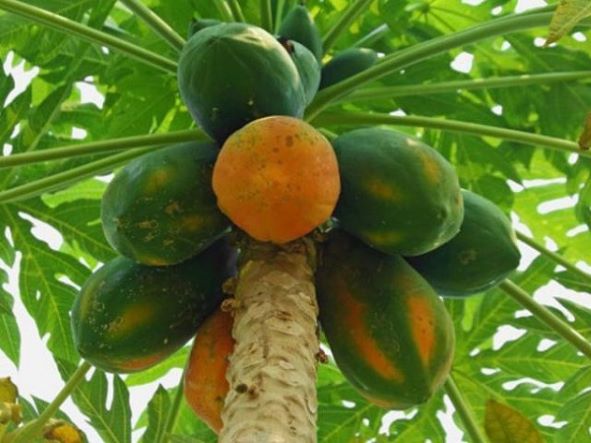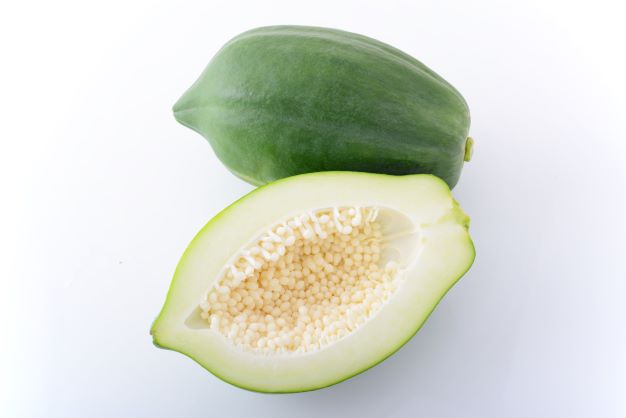Papaya is not only a delicious, nutritious fruit that brings many health benefits, but parts of the entire papaya tree are also effective medicinal herbs.
1. Characteristics of papaya
Papaya is also known as: Ca lao, phien moc.
Scientific name Carica papaya L. Belongs to the Papayaceae family.
The papaya tree provides the following parts used as medicine: green and ripe papaya fruit, papaya seeds, papaya flowers, papaya latex, papain, carpain alkaloid.
The papaya tree is 3 to 7m tall, with a straight trunk, sometimes branched. The bark bears many scars from the petioles. The leaves grow alternately at the top of the tree, the large, wide leaf blades are divided into 6-9 lobes, the lobes are ovate and pointed, the edges have irregular serrations, the petioles are hollow and 30-50cm long. The flowers are pale white or pale green, different from the original.
The male flowers grow in the leaf axils in clusters with very long stalks. The female flowers have longer corollas than the male flowers, growing in clusters in the leaf axils. The fruit is fleshy, large ovate, 20-30cm long, 15-20cm in diameter. The fruit flesh is thick, initially green, then turns orange-yellow. In the fruit core there are many black seeds as big as peppercorns, surrounded by a layer of mucus.

All parts of the papaya tree are valuable medicinal herbs.
The origin of the papaya tree is the tropical Americas, and later it was popularized everywhere.
Ripe papaya contains about 90% water, sugars, mainly glucose 8.5%, a little protein, fat, a little inorganic salts (calcium, phosphorus, iron), vitamins A, B and C…
Green papaya and other parts of the tree such as the stem, roots, leaves all contain a latex substance, the most in green fruit. A green fruit gives about 4% of its weight of latex. A tree gives about 100g of latex in a year.
In latex there are papain enzymes, rubber, resin, amino acids: Leuxin, tyrosine, fat, malic acid and hydrolytic enzymes, fat, papain enzymes have the effect of digesting meat, protein to release amino acids such as glycocola, alanine, arginine, tryptophan.
The effect of papain enzymes on meat digestion takes place in acidic, neutral or slightly alkaline environments, best at pH 6.4-6.5. The suitable temperature is quite high, can reach 80-85 degrees, but higher than 90 degrees will lose its effect.
In papain enzymes, some authors found a lot of peroxydaza enzymes, a little lipase enzymes.
In leaves, fruits and seeds (mainly in leaves) there is a bitter alkaloid called carpain and a glucoside called carposit.
The effect of carpain is almost like digitalin, a heart tonic.
According to Hooper, papaya seeds contain 26.3% oil, 24.3% albuminoid, 17% fiber, 15.5% carbohydrates, 8.8% ash and 8.2% water.
2. Pharmacological effects
– Papain enzyme has the same effect as pepsin enzyme of the stomach and especially like trypsin enzyme of the pancreas in digesting meat. It stops the growth of some gram-positive and gram-negative bacteria. Bacteria such as Staphylococcus, typhoid bacteria are very sensitive to the effects of papain.
Papain also has the effect of coagulating milk and reducing the toxicity of toxins and toxanbumin.
– Papaya latex is considered a medicine to treat worms in many places. It works on roundworms, pinworms, pork tapeworms (trichine) but does not work on hookworms (ankylostone).
Caspain slows the heart rate, some people have used it as a replacement for digitalis heart medicine.
It has been discovered that papaya seeds have strong antibiotic properties.

Green papaya crushed with water cures freckles.
3. Uses and dosage
– Ripe papaya is considered a nutritious dish and helps digest meat and egg whites.
– Green papaya cooked thoroughly with chicken is used by some military medical units to treat stomach ulcers with results. However, there are some cases of weight loss.
People also use it to cook with tough meat to make it cook quickly. Green papaya crushed with water is also used to apply on the face or hands to treat freckles on the face and hands.
– Papaya latex is used as a medicine for worms, but care must be taken to avoid danger to children and people with stomach ulcers. Sometimes it is used externally to treat foot warts and warts, eczema or psoriasis.
In the US, papaya latex is used in the beer industry, food industry, pharmaceutical industry, silk industry to prevent fibers from shrinking, and leather industry. Every year, more than 50 tons of latex are imported.
– Papaya leaves are used to wrap tough chicken meat to make it cook quickly and soften. Papaya leaf decoction is used to wash blood stains on fabrics and clothes, or to wash wounds and ulcers.
– Papaya root decoction is used as a medicine to stop bleeding in cases of hemorrhage and kidney stones.
– Fresh or dried male papaya flowers steamed with sugar or rock sugar are used to treat coughs, pneumonia, and loss of voice.
Prescription with papaya to treat stingray bites: 30g fresh papaya root; 4g salt. Crush both ingredients, squeeze to get the juice to drink, apply the pulp to the swollen and painful area. After about half an hour, the pain will subside and a few days later it will be completely cured (experience of the people in the South).
Note: Pregnant women should not eat green papaya because it can easily cause miscarriage.





